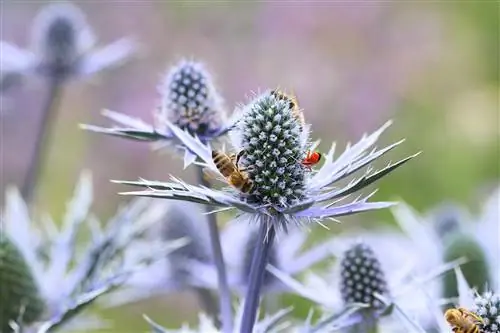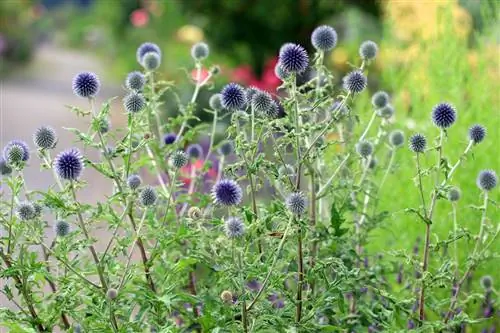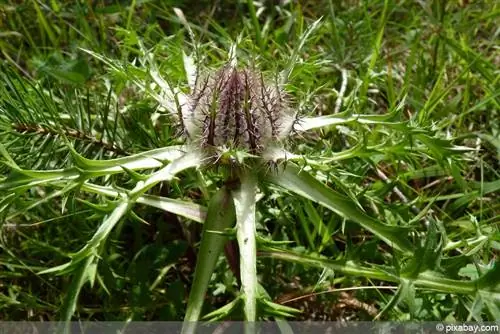- Author admin [email protected].
- Public 2023-12-17 03:39.
- Last modified 2025-06-01 06:48.
The thing all 200 species have in common is their decorative appearance, which makes them a popular plant for dry arrangements. The blue thistle is a very interesting structural plant and is characterized by its hard and thorny leaves. It also has hemispherical inflorescences with spiny leaves. It usually blooms from July to September. Since it is becoming more and more established in your own garden, we would like to give you the most important sowing and care tips for the sweet thistle man litter.
Special features of sweet thistle
- the growth habit: perennial herbaceous plant
- the stem is heavily branched at the top
- bluish corolla
- spherical inconspicuous fruit
- blooms from August to early September
- largest genus of umbelliferous plants
Where can you sow sweet thistles?
Blue thistle is rarely sown. If you still want to sow, sandy soil with a temperature of around 20 °C is advantageous. If sowing takes place using seed pots, it can be sown before mid-August and the plant can be planted outdoors before the start of winter.
Planting and transplanting thistles
- Number of plants: 6 to 8 per sqm
- Distance: there should be a distance of 30 to 40 cm between the plants
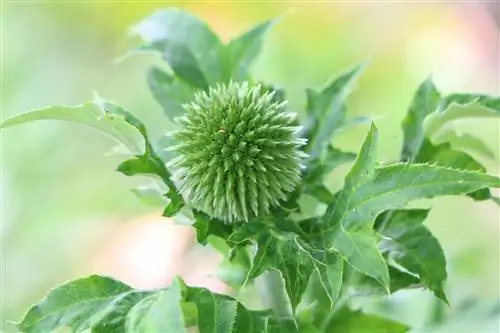
The blue thistle is usually planted in spring and is available in pots at every garden store. In any case, outdoor planting must take place by mid-September. It is important to note that the soil must be dug up properly before planting. Dig a shallow hole for the plant so that the roots are at soil level.
Tip:
Repotting the sweet thistle is not necessary. It is grown in nursery pots and then grows as an outdoor plant.
Care for thistles
The noble thistle man litter is an undemanding plant and does not require extensive care. Since the plant does not have any unusual requirements, it is very popular with many gardeners. In order for it to stand upright, it will probably need to be supported (especially in strong winds). To avoid spontaneous sowing, wilted flowers should be cut off. It is important to note that pruning takes place after flowering and that this does not take place in late autumn. Otherwise the blue thistle is very sensitive to frost.
The blue thistle absolutely does not tolerate compost. In the first year after planting you should fertilize with a mineral or organic perennial fertilizer, then every 2-3 years with top dressing.
Locations for man litter
The plant can tolerate strong sunlight and is best placed in full sun and open areas. She should get at least 4 hours of sun daily. Well-drained and unworked soil is preferred, but it can also be cultivated for lime-rich or stony soil. The plant should be protected from wind and it absolutely cannot tolerate waterlogging. So you have to avoid permanently moist soil. If the surface is heavy, you can mix it with grit or sand to make it more permeable.
In the first week after planting, you should water regularly, but not in full sun. Afterwards, it no longer needs to be watered as often; short dry periods are no problem. They grow best when they dry out briefly (don't dry out).
Overwintering thistles
The plant is very frost hardy, use some gravel when planting in the lower layer, this protects the base of the thistle from wet ground in winter. Winter cover is recommended for better development in the following year.
What you should know about sweet thistle in brief
The man litter sweet thistle is a very easy-care and beautiful plant. It has now established itself as the perfect addition to a garden. Due to its tall growth, it is also often used as a privacy screen in gardens. In winter it doesn't make the garden look too bare and gives it a structure. In summer it stands out with its steel blue flower heads and attracts attention. It is ideal for every hobby gardener as the time required for this undemanding plant is very little. It is particularly suitable for cottage gardens, Mediterranean-style gardens, natural gardens, prairie plantings, as a structural plant in flower beds and gravel gardens.
- Growth: height 30 - 120 cm, planting distance 30 - 60 cm
- Flowering: from midsummer to early autumn
- Substrate: normal, well-drained soil
- Location: as sunny as possible
- Wintering: hardy
- Propagation: in spring or autumn through spontaneous sowing or self-sowing, division and root cuttings are possible
- Diseases: since the plant is very easy to care for, you don't have to expect any disease
- Pests: Due to its prickly nature, it hardly has any enemies, so there is no need to fear pest infestation
Eryngium is highly prized for its spiny leaves and flower heads surrounded by spiny bracts. The leaves are gray-green, the flowers are light blue, steel blue or blue-violet.
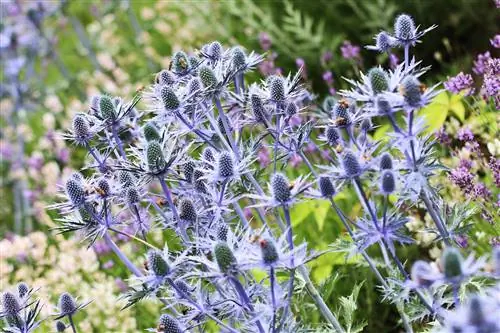
Popular types of sweet thistle
- Eryngium alpinum, the Alpine man's litter, grows to a height of 60 cm and produces dark, blue-green leaves and, from mid-summer to early autumn, steel-blue flowers with very finely divided, blue-violet bracts.
- Eryngium bourgatii reaches a height of around 60 cm and has strong grey-green, white-veined leaves alongside bluish flowers that are surrounded by narrow, steel-blue bracts.
- Eryngium giganteum grows to a height of 120 cm and has bluish, heart-shaped leaves and silver-blue to greenish flowers with long bracts. This species only flowers once and self-sows.
- Eryngium maritimum, the native sea thistle, grows to a height of 45 cm and has stiff, silver-green leaves. The large, silver bracts surround steel blue flower heads on branching stems. Flowering time is from mid-summer to early autumn.
- Eryngium x oliverianum, about 120 cm high, produces heart-shaped, blue-green leaves and bluish flowers with dark, mauve-blue, narrow bracts from mid-summer to early autumn.
- Eryngium planum, reaches a height of 90 cm, bears dark green leaves and in autumn light blue flower heads and narrow, dark green bracts.
- Eryngium variifolium is an evergreen species with a height of 75 cm. It produces shiny, rounded, dark green leaves that are marbled white. The blue flowers surrounded by silvery bracts appear in summer.

